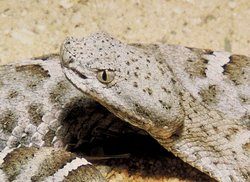Pit Viper
|
|
| Pit Vipers | ||||||||||||
|---|---|---|---|---|---|---|---|---|---|---|---|---|
 Mexican Ridge Nosed Rattlesnake | ||||||||||||
| Scientific classification | ||||||||||||
| ||||||||||||
| Genera | ||||||||||||
|
See text. |
Pit Vipers (sometimes called crotalines) are mostly New World vipers found in North, Central and South America; a few species are recorded from isolated areas of Southeast Asia, the Caspian region of Europe, China and Japan. Depending on the taxonomist, Pit Vipers may be treated as a subfamily (Crotalinae) of the viper family Viperidae (with "true vipers" or pitless vipers in the subfamily Viperinae), or as a family of their own, Crotalidae.
These snakes are named after their specialized thermoreceptors, heat-sensitive organs located on the head which take the form of small pits. There are approximately 22 genera of Pit Vipers in total, the largest and most familiar being the rattlesnakes (genera Crotalus and Sistrurus). Other species include the American copperhead and Cottonmouth (genus Agkistrodon) and the asian pit vipers (genus Gloydius).
| Contents |
Physiology
Like the pitless vipers, all crotalines are highly venomous; the Western Diamondback Rattlesnake (Crotalus atrox) is responsible for the majority of snakebite deaths in North America. Like pitless vipers, pit vipers are solenoglyphous, i.e. their fangs are hollow and hinged, folding back against the roof of the mouth when not in use. Pit Vipers also closely resemble other vipers, having broad triangular heads and heavy builds with short, stubby tails which may or may not include a rattle.
The titular pits are between the nostril and the eye on either side of the Pit Viper's head. They contain membranes sensitive to infrared radiation; this allows the snakes to detect prey whose body temperatures are higher or lower than the surrounding environment, namely small rodents, birds and lizards. The temperature difference need not be great; fractions of a degree are enough. This adaptation serves the vipers well, as they are nocturnal animals and rely heavily on this "sixth sense". This adaptation is observed in only one other group of snakes, the boas.
In terms of length, Pit Vipers range in size from the Eyelash Viper (Bothriechis schleglii) at a maximum 50 centimetres (20 inches), to the Bushmaster (Lachesis muta) at an imposing 3.5 metres (11.5 feet). Incidentally, the Bushmaster is also the largest of all vipers, and the largest venomous snake in the New World.
Habitat and behavior
Pit Vipers are a versatile group, with members found in habitats ranging from parched desert (e.g., rattlesnakes) to rainforests (e.g., fer-de-lance) and even aquatic settings (e.g., the water moccasin). Species may be either arboreal or terrestrial. Some species may be found at elevations exceeding 1,000 metres.
Although mostly nocturnal, some species are highly active by day; one example is Trimeresurus trigonocephalus, a bright green pit viper endemic to Sri Lanka with yellow and black camouflage. The majority are active by night to avoid scorching daytime temperatures and to hunt when their preferred prey are also active. The snakes' heat-sensitive pits are also thought to aid in the location of cooler areas in which to rest.
Crotalines are characteristically ambush predators, lying in patient wait for unsuspecting prey to wander by. At least one species, the arboreal Gloydius shedaoensis of China, is known to select a specific ambush site and return to it every year in time for the spring migration of birds. Studies have indicated that these snakes learn to improve their strike accuracy over time[1] (http://www.bio.usyd.edu.au/Shinelab/students/mark/349whydojuvenile.pdf).
Many temperate species (e.g. most rattlesnakes) will congregate in sheltered areas or dens to overwinter (see hibernation), the snakes benefitting from the combined heat. In cool temperatures and whilst pregnant the vipers will also bask on sunny ledges. Some species do not mass together in this way, among them the Copperheads and Mojave Rattlesnake (Cortalus scutulatus).
Like most snakes, crotalines keep to themselves and will strike only if cornered or threatened. Smaller snakes are less likely to stand their ground than are larger specimens.
Pollution and the destruction of rainforests has caused many viper species to decline in population and loose their homes. Humans also pose a major threat to vipers many vipers are hunted for their skins. Vipers also stray onto roads and are hit by cars, and are killed like household pests.
Reproduction
With few exceptions, Pit Vipers are ovoviviparous; that is, females give birth to live young. The young are well-developed and are capable of delivering a fatal bite right from the time of birth. The young snakes stay with their mother for about two weeks, or until their first molt.
Among the oviparous (egg-laying) Pit Vipers are the Bushmaster, Calloselasma species, and some Trimeresurus species. It is believed that all egg-laying crotalines guard their eggs.
Brood sizes range from two individuals in very small species to as many as 86 in the fer-de-lance, a species among the most prolific of the live-bearing snakes. Many young crotalines have brightly coloured tails which contrast dramatically with the rest of their bodies; using worm-like movements, the young snakes may use their tails as a lure.
Genera
- Agkistrodon
- Atropoides
- Bothriechis
- Bothriopsis
- Bothrocophias
- Bothrops
- Calloselasma
- Cerrophidion
- Crotalus (See Rattlesnake)
- Deinagkistrodon
- Ermia
- Gloydius
- Hypnale
- Lachesis
- Ophryacus
- Ovophis
- Porthidium
- Protobothrops
- Sistrurus
- Triceratolepidophis
- Trimeresurus (Green pit viper / Bamboo viper)
- Tropidolaemus
